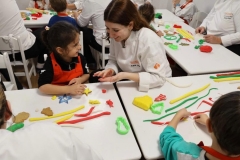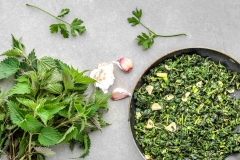
SCHOOL OF APPLIED MANAGEMENT SCIENCES
Gastronomy and Culinary Arts Program
CLM 402 | Course Introduction and Application Information
| Course Name |
Cost Analysis and Control
|
|
Code
|
Semester
|
Theory
(hour/week) |
Application/Lab
(hour/week) |
Local Credits
|
ECTS
|
|
CLM 402
|
Fall/Spring
|
2
|
2
|
3
|
5
|
| Prerequisites |
None
|
|||||
| Course Language |
English
|
|||||
| Course Type |
Service Course
|
|||||
| Course Level |
First Cycle
|
|||||
| Mode of Delivery | - | |||||
| Teaching Methods and Techniques of the Course | - | |||||
| Course Coordinator | - | |||||
| Course Lecturer(s) | ||||||
| Assistant(s) | - | |||||
| Course Objectives | This course gives the students an understanding of flow of goods in a typical food service operation, analyze of market flows and product costs, costing and pricing of a menu, calculation food cost percentages, determination of food cost based on sales , purchasing and inventory values and management of F&B operations via cost analysis. |
| Learning Outcomes |
The students who succeeded in this course;
|
| Course Description | In this course, management of income and expenses in food and beverage companies will be examined and the contribution of cost analysis to business management and profit planning processes will be explained. Calculation of costs, inventory management and sales forecasting issues will be reinforced by applied case studies. |
|
|
Core Courses | |
| Major Area Courses |
X
|
|
| Supportive Courses | ||
| Media and Management Skills Courses | ||
| Transferable Skill Courses |
WEEKLY SUBJECTS AND RELATED PREPARATION STUDIES
| Week | Subjects | Related Preparation |
| 1 | Managing Revenue and Expenses | Dopson, L. R., & Hayes, D. K.” Food and Beverage Cost Control”, Chapter 1, Managing Revenue and Expense, 4th edn., (John Wiley & Sons,2008), 1-22 |
| 2 | Determining Sales Forecasts | Dopson, L. R., & Hayes, D. K.” Food and Beverage Cost Control”, Chapter 2, Determining Sales Forecasts, 4th edn., (John Wiley & Sons,2008), 27-48 |
| 3 | Managing the Cost of Food | Dopson, L. R., & Hayes, D. K.” Food and Beverage Cost Control”, Chapter 3, Managing the Cost of Food, 4th edn., (John Wiley & Sons,2008), 53-122 |
| 4 | Managing the Cost of Beverages | Dopson, L. R., & Hayes, D. K.” Food and Beverage Cost Control”, Chapter 4, Managing the Cost of Beverages, 4th edn., (John Wiley & Sons,2008), 130-153 |
| 5 | Managing the Food and Beverage Production Process | Dopson, L. R., & Hayes, D. K.” Food and Beverage Cost Control”, Chapter 5, Managing the Food and Beverage Production Process, 4th edn., (John Wiley & Sons,2008), 172-223 |
| 6 | Managing Food and Beverage Pricing | Dopson, L. R., & Hayes, D. K.” Food and Beverage Cost Control”, Chapter 6, Managing the Food and Beverage Pricing, 4th edn., (John Wiley & Sons,2008), 230-257 |
| 7 | Managing the Cost of Labor | Dopson, L. R., & Hayes, D. K.” Food and Beverage Cost Control”, Chapter 7, Managing the Cost of Labor, 4th edn., (John Wiley & Sons,2008), 267-320 |
| 8 | Midterm Exam | |
| 9 | Controlling Other Expenses | Dopson, L. R., & Hayes, D. K.” Food and Beverage Cost Control”, Chapter 8, Controlling Other Expenses, 4th edn., (John Wiley & Sons,2008), 328-352 |
| 10 | Analyzing Results Using the Income Statement | Dopson, L. R., & Hayes, D. K.” Food and Beverage Cost Control”, Chapter 9, Analyzing Results Using the Income Statement, 4th edn., (John Wiley & Sons,2008), 358-382 |
| 11 | Planning for Profit | Dopson, L. R., & Hayes, D. K.” Food and Beverage Cost Control”, Chapter 10, Planning for Profit, 4th edn., (John Wiley & Sons,2008), 386-428 |
| 12 | Maintaining and Improving the Revenue Control Systems | Dopson, L. R., & Hayes, D. K.” Food and Beverage Cost Control”, Chapter 11, Maintaining and Improving the Revenue Control System, 4th edn., (John Wiley & Sons,2008), 438-467 |
| 13 | Global Dimensions of Cost Control | Dopson, L. R., & Hayes, D. K.” Food and Beverage Cost Control”, Chapter 12, Global Dimensions of Management and the Role of Technology, 4th edn., (John Wiley & Sons,2008), 470-498 |
| 14 | Training Staff | Dittmer, P., Keefe, J. D., Hoyer, G., & Foster, T. “Principles of Food, Beverage, and Labor Cost Controls. “, Chapter 20, Training Staff, 9th edn., (J. Wiley, 2009), |
| 15 | Review of Semester | |
| 16 | Final Exam |
| Course Notes/Textbooks | Jack E. Miller, L. Dopson, D. Hayes, “Food & Beverage Cost Control”, 4th Ed., Wiley Publishing, 2007. ISBN 978-0-471-69-417-5. |
| Suggested Readings/Materials | Dittmer, P., Keefe, J. D., Hoyer, G., & Foster, T. “Principles of Food, Beverage, and Labor Cost Controls.”, 9th edn., J. Wiley, 2009, ISBN 978-0-471-78347-3 Lynch, F. T., The Book of Yields: Accuracy in Food Costing and Purchasing. 8th edn, John Wiley & Sons, 2011, ISBN 978-0-470-19749-3 |
EVALUATION SYSTEM
| Semester Activities | Number | Weigthing |
| Participation |
1
|
10
|
| Laboratory / Application | ||
| Field Work | ||
| Quizzes / Studio Critiques |
1
|
10
|
| Portfolio | ||
| Homework / Assignments |
1
|
20
|
| Presentation / Jury | ||
| Project | ||
| Seminar / Workshop | ||
| Oral Exams | ||
| Midterm |
1
|
25
|
| Final Exam |
1
|
35
|
| Total |
| Weighting of Semester Activities on the Final Grade |
4
|
65
|
| Weighting of End-of-Semester Activities on the Final Grade |
1
|
35
|
| Total |
ECTS / WORKLOAD TABLE
| Semester Activities | Number | Duration (Hours) | Workload |
|---|---|---|---|
| Theoretical Course Hours (Including exam week: 16 x total hours) |
16
|
2
|
32
|
| Laboratory / Application Hours (Including exam week: '.16.' x total hours) |
16
|
2
|
32
|
| Study Hours Out of Class |
16
|
1
|
16
|
| Field Work |
0
|
||
| Quizzes / Studio Critiques |
1
|
10
|
10
|
| Portfolio |
0
|
||
| Homework / Assignments |
1
|
15
|
15
|
| Presentation / Jury |
0
|
||
| Project |
0
|
||
| Seminar / Workshop |
0
|
||
| Oral Exam |
0
|
||
| Midterms |
1
|
20
|
20
|
| Final Exam |
1
|
25
|
25
|
| Total |
150
|
COURSE LEARNING OUTCOMES AND PROGRAM QUALIFICATIONS RELATIONSHIP
|
#
|
Program Competencies/Outcomes |
* Contribution Level
|
||||
|
1
|
2
|
3
|
4
|
5
|
||
| 1 | Successfully applies theoretical and practical knowledge and skills in Gastronomy and Culinary Arts |
X | ||||
| 2 | Carries best practices in terms of work and food security, safety and hygiene in food production |
|||||
| 3 | Appreciates, evaluates and makes decisions regarding to visual, textual and nutritional data with respect to food production and presentation |
|||||
| 4 | Recognizes and evaluates the impact of gastronomy on culture and society |
|||||
| 5 | Assumes responsibility for solving complex problems that may occur in the field of Gastronomy and Culinary Arts, both individually and as a team member |
|||||
| 6 | Evaluates the knowledge and skills acquired in the field of Gastronomy and Culinary Arts with a critical approach and effectively communicate their ideas and suggestions for solutions in written and oral form. |
|||||
| 7 | Possesses necessary knowledge and skills in relevant fields such as gastronomy, design, law and management and effectively apply them to the practice of Culinary Arts |
X | ||||
| 8 | Uses the technological tools related to Gastronomy and Culinary Arts effectively |
X | ||||
| 9 | Updates and improve the knowledge, skills and competencies related to Gastronomy and Culinary Arts with lifelong learning awareness and sustainability with an ethical approach |
X | ||||
| 10 | Collects data in the areas of Gastronomy and Culinary Arts and communicate with colleagues in a foreign language. (European Language Portfolio Global Scale”, Level B1) |
X | ||||
| 11 | Speaks a second foreign at a medium level of fluency efficiently |
X | ||||
| 12 | Relates the knowledge gained through the history of humanity to the field of expertise |
X | ||||
*1 Lowest, 2 Low, 3 Average, 4 High, 5 Highest
NEWS |ALL NEWS

Aegean flavors from the chefs of the future
Izmir University of Economics (IUE) Department of Gastronomy and Culinary Arts left its mark on the 6th Izmir GastroFest, organized this year with
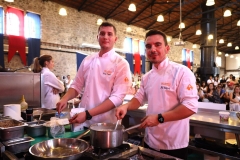
They added flavor to GURMEFEST
GURMEFEST, one of the biggest food, drink and entertainment festivals of Izmir, was ‘flavored’ with the dishes prepared and presented by the
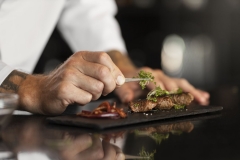
“Izmir and Bodrum will class up”
The MICHELIN Guide, one of the most prestigious restaurant rating systems in the world, has added Izmir and Bodrum to its Turkish
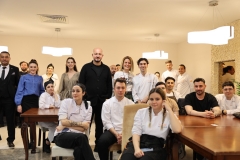
IUE graduates will prepare the flavors unique to Turkish cuisine
Bilsev Group, who is preparing to expand to Dubai this year with its Ferdi Baba, Fabrice Restaurant and Baba Pizza brands, will
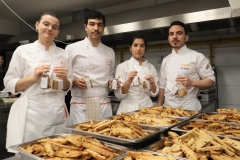
They prepared products that are filling and have a long shelf life
25 students of Department of Gastronomy and Culinary Arts of Izmir University of Economics (IUE) prepared products with a long shelf life,




